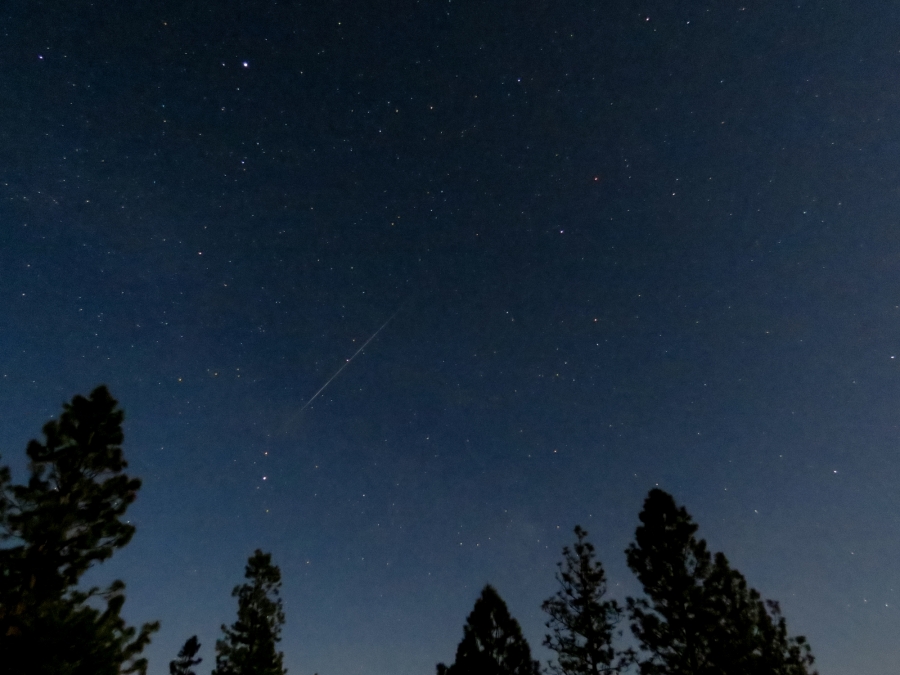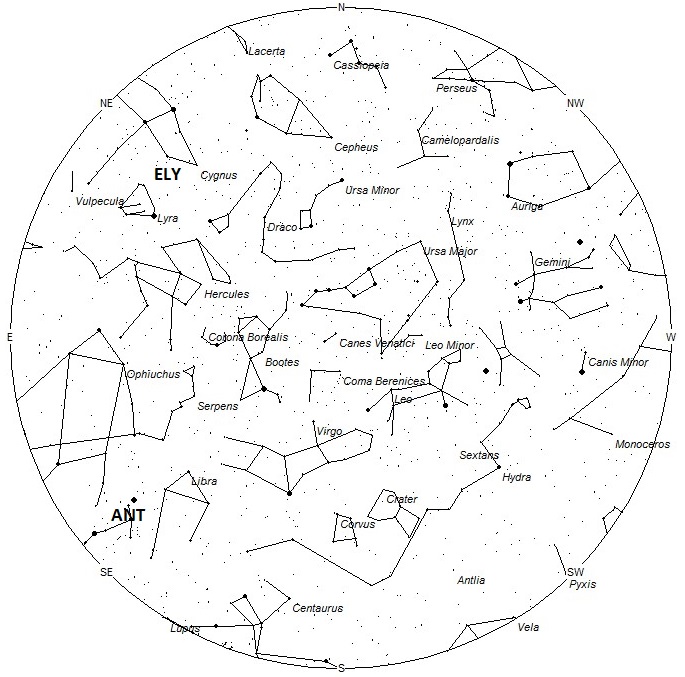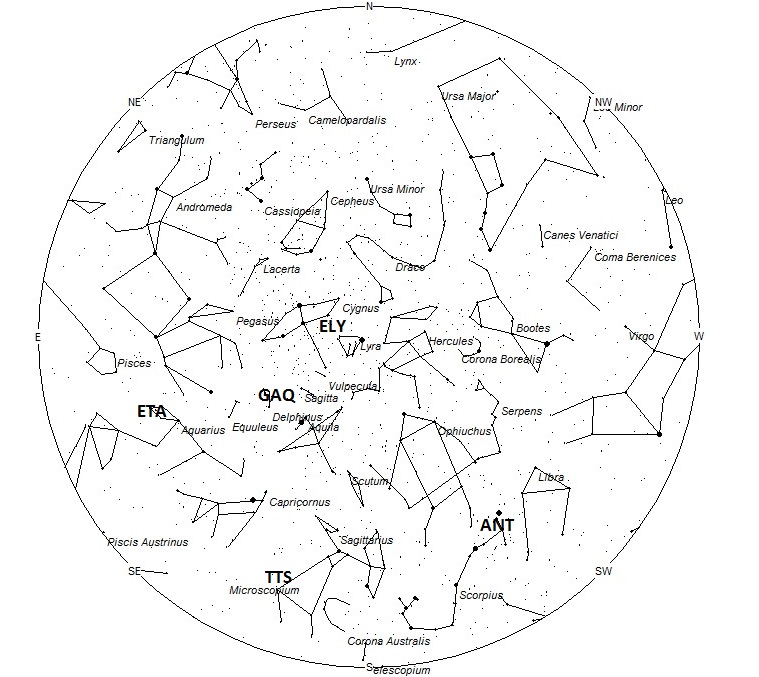
Photo shared on the American Meteor Society’s website – ©Rocky Raybell – 2015-04-30 02:14 – PDT
Eta Aquarid Meteor near Keller, Washington
During this period the moon reaches its last quarter phase on Monday May 11th. At this time the moon will be located 90 degrees west of the sun and will rise near 0100 local daylight saving time (LDT). This weekend the waning gibbous moon will rise near midnight LDT and spoil the dark sky for the remainder of the night. As the week progresses the conditions improve as the moon wanes and rises later each night. The estimated total hourly meteor rates for evening observers this week is near 2 for observers situated at mid-northern latitudes and 3 for observers viewing from the southern tropics (latitude 25 S.). For morning observers the estimated total hourly rates should be near 9 for observers situated at mid-northern latitudes and 13 for observers viewing from the southern tropics. The actual rates will also depend on factors such as personal light and motion perception, local weather conditions, alertness and experience in watching meteor activity. Rates during the morning hours are reduced due to moonlight. Note that the hourly rates listed below are estimates as viewed from dark sky sites away from urban light sources. Observers viewing from urban areas will see less activity as only the brightest meteors will be visible from such locations.
The radiant (the area of the sky where meteors appear to shoot from) positions and rates listed below are exact for Saturday night/Sunday morning May 9/10 These positions do not change greatly day to day so the listed coordinates may be used during this entire period. Most star atlases (available at science stores and planetariums) will provide maps with grid lines of the celestial coordinates so that you may find out exactly where these positions are located in the sky. A planisphere or computer planetarium program is also useful in showing the sky at any time of night on any date of the year. Activity from each radiant is best seen when it is positioned highest in the sky, either due north or south along the meridian, depending on your latitude. It must be remembered that meteor activity is rarely seen at the radiant position. Rather they shoot outwards from the radiant so it is best to center your field of view so that the radiant lies at the edge and not the center. Viewing there will allow you to easily trace the path of each meteor back to the radiant (if it is a shower member) or in another direction if it is a sporadic. Meteor activity is not seen from radiants that are located below the horizon. The positions below are listed in a west to east manner in order of right ascension (celestial longitude). The positions listed first are located further west therefore are accessible earlier in the night while those listed further down the list rise later in the night.
These sources of meteoric activity are expected to be active this week.
The center of the large Anthelion (ANT) radiant is currently located at 16:08 (242) -21. This position lies in western Scorpius, between the bright stars known as Acrab (Beta Scorpii) and Dschubba (Delta Scorpii). Due to the large size of this radiant, Anthelion activity may also appear from Libra, northern Lupus, southern Ophiuchus, as well as Scorpius. This radiant is best placed near 0100 LDT, when it lies on the meridian and is located highest in the sky. Rates at this time should be near 2 per hour as seen from the northern hemisphere and 3 per hour as seen from south of the equator. With an entry velocity of 30 km/sec., the average Anthelion meteor would be of slow velocity.
The Eta Lyrids (ELY) are active from May 5-12 with a maximum activity occurring on May 10. The radiant is located at 19:24 (291) +43. This area of the sky lies on the Cygnus-Lyra border, 5 degrees southwest of the third magnitude star Rukh (Delta Cygni). The radiant is best placed just before the break of dawn when the radiant lies highest in the sky. While Eta Lyrid meteors can be seen in both hemispheres, the north is favored as the radiant lies much higher in the sky. Hourly rates are expected to be 2-3 from the northern hemisphere and less than one from the southern hemisphere. At 43km/sec. the Eta Lyrids would produce meteors of medium-swift velocity.
The Theta 2 Sagittariids (TTS) are a new discovery of the IMO video network using cameras active in Australia. These meteors are active from May 9-14, which maximum activity occurring on the 13th. The radiant lies near the position of 20:04 (301) -33. This area of the sky lies in southeastern Sagittarius, 2 degrees northeast of the 4th magnitude star Theta 2 Sagittarii. The radiant is best placed just before the break of dawn when the radiant lies highest in the sky. While Theta 2 Sagittariid meteors can be seen in both hemispheres, the south is favored as the radiant lies higher in their sky. Hourly rates are expected to be less than 1 no matter your location. At 67km/sec. the Theta 2 Sagittariids would produce meteors of swift velocity.
The Gamma Aquilids (GAQ) were discovered by members of the Croatian Meteor Network using various sources for data. These meteors are active from May 5-12, with maximum activity occurring on May 8th. The radiant is currently located at 20:28 (307) +14. This area of the sky is actually located in Delphinus, just west of the 4th magnitude star known as Rotanev (Beta Delphini). This radiant is best placed near 0500 LDT, when it lies on the meridian and is located highest in the sky. Rates at this time should be less than 1 per hour no matter your location. With an entry velocity of 66 km/sec., the average Gamma Aquilid meteor would be of swift velocity.
The Eta Aquariids (ETA) peaked near May 7th and rates are now slowly falling. The radiant is currently located near 22:36 (339) -01. This position lies in northern Aquarius, just south of the 4th magnitude star known as Eta Aquarii. This radiant is best placed during the last dark hour before dawn when it lies highest above the horizon in a dark sky. Rates at this time should be near 3 per hour as seen from the northern hemisphere and 5 as seen from south of the equator. With an entry velocity of 67 km/sec., the average meteor from this source would be of swift velocity with a high percentage of persistent trains on the brighter meteors.
As seen from the mid-northern hemisphere (45N) one would expect to see approximately 3 sporadic meteors per hour during the last hour before dawn as seen from rural observing sites. Evening rates would be near 2 per hour. As seen from the tropical southern latitudes (25S), morning rates would be near 5 per hour as seen from rural observing sites and 3 per hour during the evening hours. Locations between these two extremes would see activity between the listed figures. Morning rates are reduced due to interfering moonlight.
The list below offers the information from above in a condensed form. Rates and positions are exact for Saturday night/Sunday morning.
| SHOWER | DATE OF MAXIMUM ACTIVITY | CELESTIAL POSITION | ENTRY VELOCITY | CULMINATION | HOURLY RATE | CLASS |
| RA (RA in Deg.) DEC | Km/Sec | Local Daylight Saving Time | North-South | |||
| Anthelions (ANT) | – | 16:08 (242) -21 | 30 | 01:00 | 2 – 3 | II |
| Eta Lyrids (ELY) | May 10 | 19:24 (291) +43 | 43 | 05:00 | 1 – <1 | II |
| Theta 2 Sagittariids (TTS) | May 13 | 20:04 (301) -33 | 67 | 06:00 | <1 – <1 | IV |
| Gamma Aquilids (GAQ) | May 08 | 20:28 (307) +14 | 66 | 06:00 | <1 – <1 | IV |
| Eta Aquariids (ETA) | May 07 | 22:36 (339) -01 | 67 | 08:00 | 3 – 5 | I |
 American Meteor Society
American Meteor Society


I must have seen the same thing, 5/9/15 around 8:30 a.m.! I live at Lake Tahoe and I was looking west toward the lake and say a very bright white light shooting down toward the mountains and I could even see the tail! Spectacular sight because I have never seen anything like this during the day!
I, and a few other friends separately observed a single meteor after midnight, est, May 17th while driving west from Augusta, GA. The head was a green glow, followed by a tapering yellow fiery tail. Incredible and amazed to be in the right place at the right time. It was heading in a northerly direction, and looking to be in the outer reaches of our atmosphere, really close, compared to other “showers” I’ve observed. This is probably in the wrong time configuration, since it was 12:45ish Sunday morning, 5-17…
My daughter called me freaking out that she saw what looks to her like a meteorite or meteor from Los Angeles County towards the west north sky I just wanna know what it is please